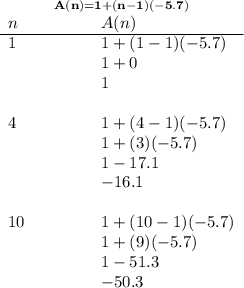
Mathematics, 03.07.2019 18:00 mattsucre1823
Find the first, fourth, and tenth terms of the arithmetic sequence described by the given rule. a(n) = 1 + (n – 1)(–5.7) 1, –21.8, –56 –5.7, –21.8, –51.3 1, –16.1, –50.3 0, –17.1, –51.3 if someone answers this, i'd like if someone could me to know how to solve it too, and you!

Answers: 2


Another question on Mathematics

Mathematics, 22.06.2019 00:00
Let u = {q, r, s, t, u, v, w, x, y, z} a = {q, s, u, w, y} b = {q, s, y, z} c = {v, w, x, y, z}. list the elements in the set.a ∩ (b ∪ c)a) {q, s, w, y}b) {q, y, z}c) {q, s, u, w, y, z}d) {q, r, w, y, z}
Answers: 1

Mathematics, 22.06.2019 00:30
Jenny borrowed $500 for five years at 4 percent interest, compounded annually. what is the total amount she will have paid when she pays off the loan? total amount = p (1 + i)t a. $608.33 b. $729.99 c. $765.77 reset next
Answers: 1

Mathematics, 22.06.2019 00:50
Given: ab ≅ bc and ao ≅ oc ok − angle bisector of ∠boc find: m∠aok
Answers: 2

Mathematics, 22.06.2019 02:00
16x^2-16x=5 solve the equation by completing the square
Answers: 3
You know the right answer?
Find the first, fourth, and tenth terms of the arithmetic sequence described by the given rule. a(n)...
Questions


Computers and Technology, 10.10.2019 04:30

History, 10.10.2019 04:30



Mathematics, 10.10.2019 04:30

History, 10.10.2019 04:30


Mathematics, 10.10.2019 04:30




History, 10.10.2019 04:30

Mathematics, 10.10.2019 04:30


Mathematics, 10.10.2019 04:30



Chemistry, 10.10.2019 04:30




